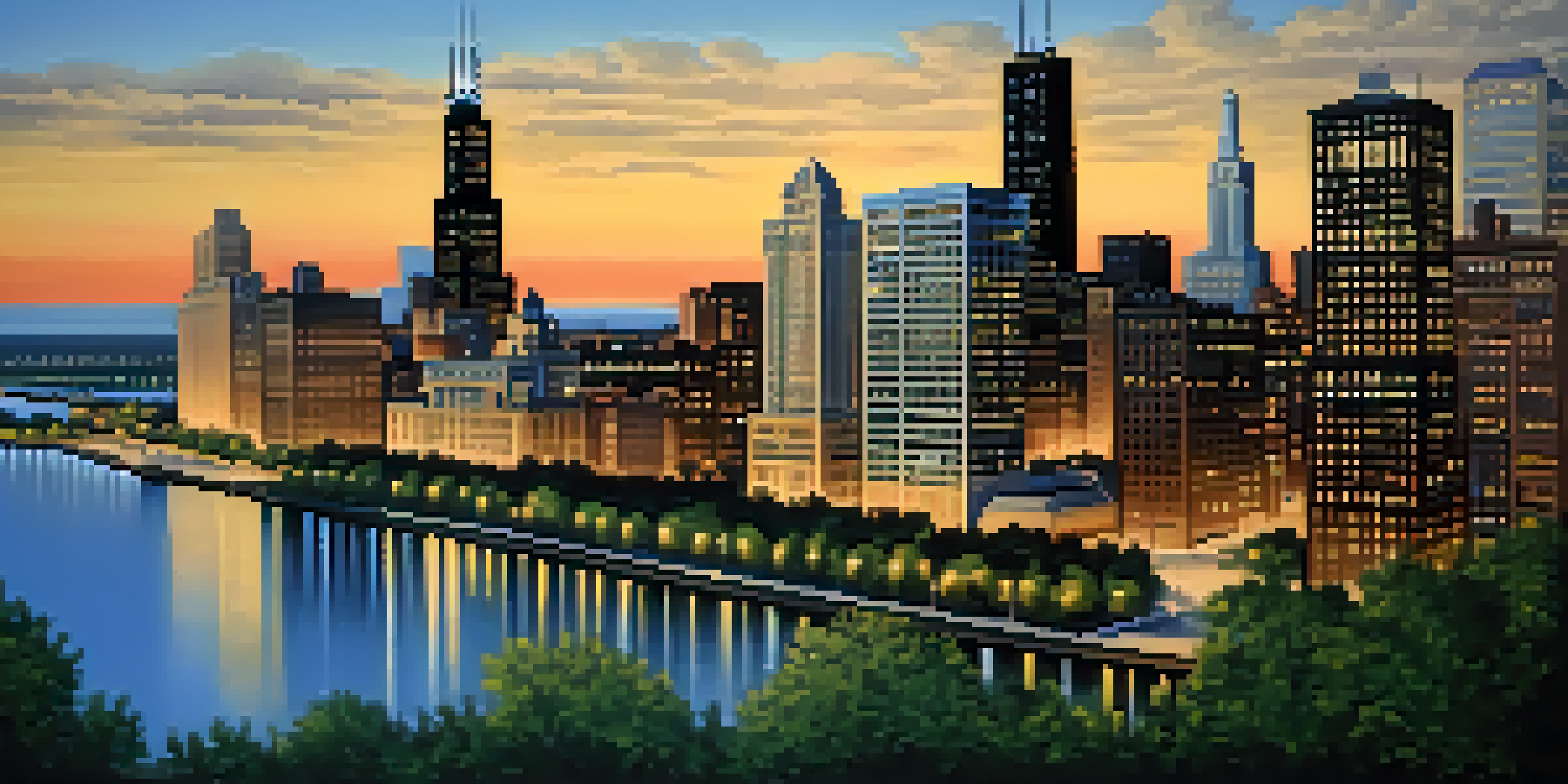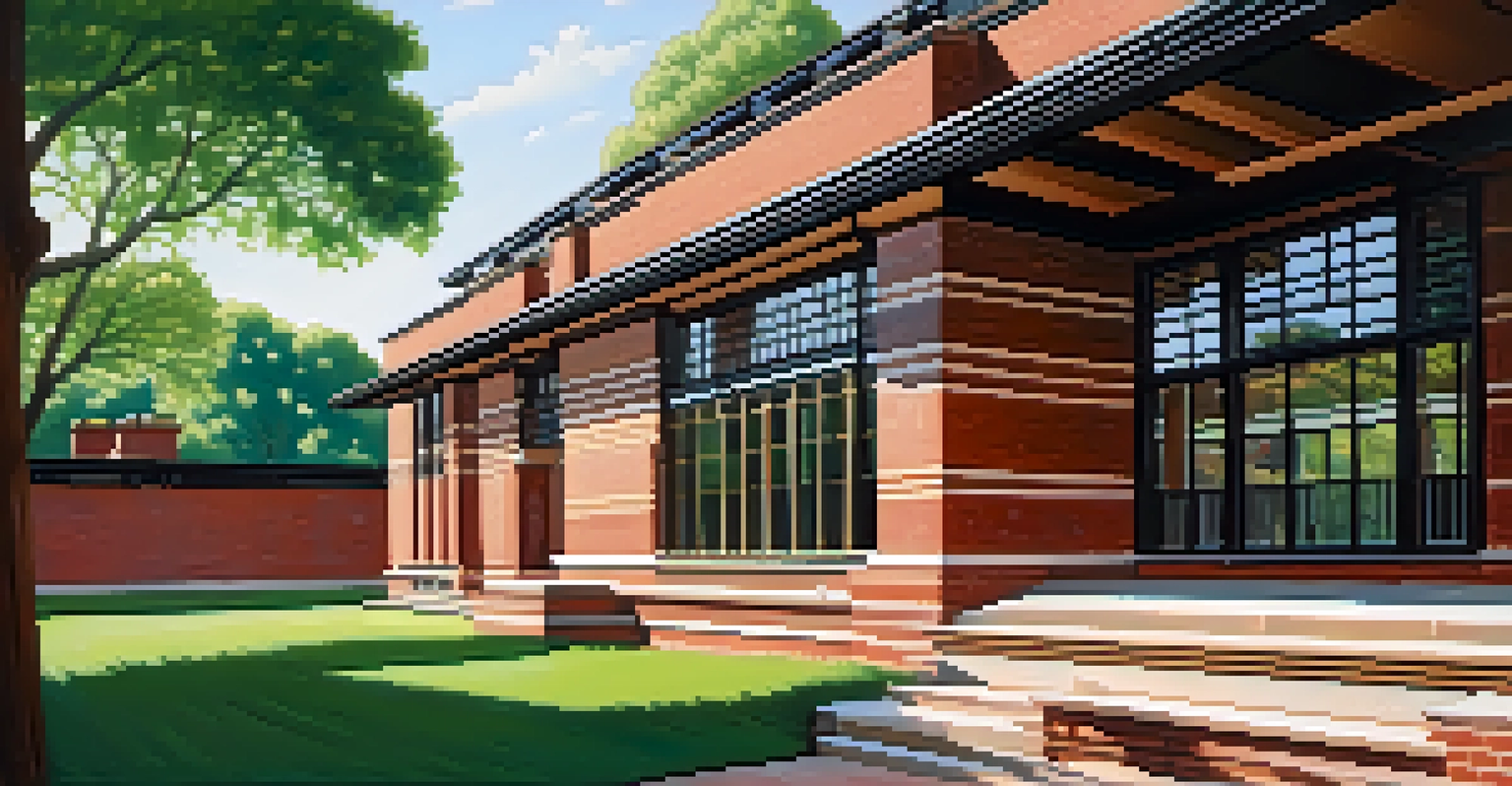Chicago's Architectural Marvels: A Historical Overview

The Birth of Chicago's Architectural Identity
Chicago's architectural story begins in the aftermath of the Great Fire of 1871, which devastated much of the city. This catastrophe prompted a remarkable rebuilding effort, leading to innovative designs that would shape the skyline. Architects began to experiment with new materials, notably steel and glass, paving the way for the modern skyscraper.
Architecture is the art of how to waste space.
One of the most iconic structures from this era is the Home Insurance Building, often considered the first skyscraper. Completed in 1885, it stood at ten stories tall, a radical departure from traditional architecture of the time. Its design showcased the potential of steel-frame construction, inspiring countless buildings in Chicago and beyond.
As the city rebuilt, the Chicago School of Architecture emerged, characterized by its emphasis on form following function. This movement not only transformed Chicago's landscape but also set the stage for modernist architecture globally, making the city a pivotal site in architectural history.
The Influence of the Prairie School Movement
In the early 20th century, the Prairie School movement emerged, championed by architects like Frank Lloyd Wright. This style emphasized harmony with the landscape, using low, horizontal lines that blended seamlessly with the natural surroundings. Wright's designs, such as the Robie House, exemplified this approach, creating a sense of unity between architecture and nature.

The Prairie School also focused on craftsmanship, with intricate details and custom furnishings that made each home unique. This dedication to artistry was a departure from the mass production of houses seen in other parts of the country. As a result, Chicago became known for its beautiful, one-of-a-kind residential designs.
Chicago's Architectural Evolution
From the Great Fire's aftermath to modern skyscrapers, Chicago's architecture reflects a dynamic blend of styles and innovations.
This movement not only shaped the aesthetic of the city but also influenced subsequent architectural trends, emphasizing the importance of integrating buildings into their environments. The legacy of the Prairie School can still be seen in many modern designs that prioritize sustainability and ecological sensitivity.
The Rise of the Chicago Skyscraper
The early 20th century marked a golden age for skyscrapers in Chicago, with iconic buildings like the Willis Tower (formerly Sears Tower) and the John Hancock Center rising dramatically. These structures pushed the boundaries of engineering and design, showcasing the city’s ambition and modernity. The Willis Tower, completed in 1973, was the tallest building in the world for over two decades.
The mother art is architecture. Without an architecture of our own, we have no soul of our own civilization.
Architects like Skidmore, Owings & Merrill played a crucial role in this skyscraper boom, integrating cutting-edge technology with sleek aesthetics. Their designs often included features like sky lobbies and glass exteriors, which not only provided stunning views but also showcased the advancements in construction materials. This innovation made skyscrapers a symbol of progress and economic growth.
Today, Chicago remains a hub for architectural innovation, with new skyscrapers continuing to change the skyline. Each new structure adds to the city’s rich tapestry of architectural styles, ensuring that the legacy of the Chicago skyscraper endures for future generations.
Art Deco and the Chicago Skyline
The Art Deco movement took the architectural world by storm in the 1920s, and Chicago was no exception. Buildings like the Chicago Board of Trade and the Carbide & Carbon Building showcase the bold geometric shapes and decorative elements characteristic of this style. These structures brought a sense of glamour and sophistication to the city’s skyline.
Art Deco architecture often incorporated bright colors, intricate ornamentation, and modern materials, reflecting the optimism of the Roaring Twenties. The Carbide & Carbon Building, for instance, features a stunning green terra cotta facade with gold accents, making it one of the most recognizable buildings in Chicago. This aesthetic appeal contributed to the city’s allure as a cultural and economic center.
Sustainability at the Forefront
Chicago leads in sustainable architecture, focusing on eco-friendly designs that enhance urban living and reduce environmental impact.
As Chicago embraced Art Deco, it also set the stage for future architectural experimentation. The blending of styles during this era allowed architects to push the boundaries of design, laying the groundwork for the postmodern styles that would follow.
Postmodernism and Chicago's Architectural Evolution
The late 20th century saw the rise of postmodernism, which reacted against the minimalist approach of modernism. Chicago became a battleground for these contrasting styles, with architects like Richard Meier and Helmut Jahn reinterpreting traditional forms. The AT&T Building (now the Sony Building) is a prime example, featuring a distinctive Chippendale-style roofline that breaks away from conventional skyscraper design.
Postmodern architecture in Chicago often embraced historical references, bright colors, and playful designs. This era encouraged creativity and individuality, allowing architects to explore new ideas while paying homage to the city’s architectural heritage. The playful nature of postmodernism brought a sense of joy to the urban landscape, making buildings more approachable.
Today, Chicago’s skyline reflects this evolution, showcasing a diverse array of styles that tell the story of the city’s architectural journey. The blend of modernist and postmodernist elements ensures that Chicago remains a dynamic and exciting place for architecture enthusiasts.
Sustainable Architecture: Chicago's Green Future
As the world becomes more aware of environmental issues, Chicago has stepped up to lead the charge in sustainable architecture. The city is home to groundbreaking projects like the LEED-certified Center for Green Technology, which serves as a model for eco-friendly design. This building utilizes renewable energy sources and emphasizes the importance of sustainability in urban planning.
Sustainable architecture in Chicago goes beyond mere energy efficiency; it also focuses on enhancing the quality of life for residents. Green roofs, rainwater harvesting systems, and the use of local materials are just a few ways that contemporary architects are addressing environmental challenges. These innovations not only reduce the city’s carbon footprint but also create healthier living spaces.
Preserving Architectural Heritage
The city's commitment to preserving its architectural heritage fosters a sense of identity while accommodating modern growth.
Chicago's commitment to sustainability is evident in its policies and initiatives, including the Chicago Climate Action Plan. This forward-thinking approach ensures that the city’s architectural landscape continues to evolve, making it a leader in the green building movement. As a result, future generations will enjoy a vibrant and sustainable urban environment.
Preserving Chicago's Architectural Heritage
As Chicago continues to grow and change, preserving its architectural heritage becomes increasingly important. The city boasts numerous historic districts and landmarks that tell the story of its rich past, including the Chicago Architecture Foundation, which promotes awareness and appreciation of local architecture. This organization offers tours and educational programs to help residents and visitors understand the significance of these structures.
Restoration efforts aim to maintain the character of historic buildings while adapting them for modern use. For instance, the transformation of the former Marshall Field's department store into a luxury hotel showcases how preservation can breathe new life into iconic spaces. Such initiatives not only honor the city’s history but also contribute to its economic vitality.

Preserving Chicago's architectural heritage is not just about maintaining old buildings; it's about fostering a sense of identity and community. By valuing the past, the city can create a future that respects its history while embracing innovation and growth.